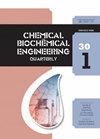Enhanced Removal of the Xenobiotic Surfactant Sodium Dodecyl Sulfate from Actual Nondomestic Wastewaters Using Immobilized Mixed Bacterial Cells
IF 0.9
4区 生物学
Q4 BIOTECHNOLOGY & APPLIED MICROBIOLOGY
引用次数: 0
Abstract
Cell immobilization has been proven to offer noticeable benefits over conventional biological systems using free cells, particularly for recalcitrant compounds. In this study, mixed bacterial cells were alternatively immobilized in sodium alginate (SA) and in sodium alginate-polyvinyl alcohol (SA – PVA) for biodegradation of sodium dodecyl sulfate (SDS). Synthetically prepared SDS-bearing aqueous solution (SWW), as well as actual automobile service station wastewater (AWW) and laundry wastewater (LWW) were used. The results revealed that high removal efficiencies were achieved after 48 h for both types of beads. When SDS concentration in SWW increased from 10 to 1000 mg L –1 , SDS degradation using both types of beads were decreased from 99.71 % to 85.12 % using SA beads, and from 99.63 % to 83.29 % using SA-PVA beads. The removal efficiency of SDS in the actual (AWW) were 94.91 % and 93.82 % using SA beads and SA-PVA beads, respectively. While, for SDS-bearing laundry (LWW), the removal efficiencies were 94.39 % and 92.04 % using SA beads and SA-PVA beads, respectively. No decline in the biodegradation capacity of immobilized consortium was noted over its recycling and reuse. Both hydrogel matrices lasted for up to five cycles in the actual wastewaters. These promising results confirmed the validity of using immobilized mixed cells as an efficient and cost-effective approach for SDS biodegradation in real industrial wastewaters.固定化混合细菌细胞对非生活污水中外源性表面活性剂十二烷基硫酸钠的强化去除
与使用游离细胞的传统生物系统相比,细胞固定化已被证明具有明显的优势,特别是对于顽固化合物。在这项研究中,混合细菌细胞交替固定在海藻酸钠(SA)和海藻酸钠-聚乙烯醇(SA - PVA)中,用于生物降解十二烷基硫酸钠(SDS)。采用合成的含sds水溶液(SWW),以及实际的汽车加油站废水(AWW)和洗衣废水(LWW)。结果表明,两种类型的微球在48 h后都达到了很高的去除效率。当SDS在SWW中的浓度从10 mg L -1增加到1000 mg L -1时,SA珠和SA- pva珠的SDS降解率分别从99.71%和99.63%降低到85.12%和83.29%。SA珠粒和SA- pva珠粒对实际AWW中SDS的去除率分别为94.91%和93.82%。而对于含有sds的洗衣(LWW), SA珠粒和SA- pva珠粒的去除率分别为94.39%和92.04%。在循环利用过程中,固定化联合体的生物降解能力没有下降。这两种水凝胶基质在实际废水中都能维持5个循环。这些有希望的结果证实了固定化混合细胞作为一种高效、经济的方法在实际工业废水中生物降解SDS的有效性。
本文章由计算机程序翻译,如有差异,请以英文原文为准。
求助全文
约1分钟内获得全文
求助全文
来源期刊
CiteScore
2.70
自引率
6.70%
发文量
23
审稿时长
>12 weeks
期刊介绍:
The journal provides an international forum for presentation of original papers, reviews and discussions on the latest developments in chemical and biochemical engineering. The scope of the journal is wide and no limitation except relevance to chemical and biochemical engineering is required.
The criteria for the acceptance of papers are originality, quality of work and clarity of style. All papers are subject to reviewing by at least two international experts (blind peer review).
The language of the journal is English. Final versions of the manuscripts are subject to metric (SI units and IUPAC recommendations) and English language reviewing.
Editor and Editorial board make the final decision about acceptance of a manuscript.
Page charges are excluded.

 求助内容:
求助内容: 应助结果提醒方式:
应助结果提醒方式:


